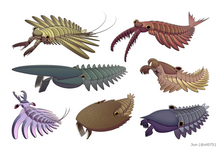
Back شعاعيات الأسنان Arabic Радиодонти Bulgarian Radiodonts Catalan Radiodonta German Radiodonta Spanish پرهدندانسانان Persian Radiodonta ID ラディオドンタ類 Japanese Radiodonta Dutch Radiodonta Portuguese
| Radiodonta Temporal range:
| |
|---|---|

| |
| Left to right, top to bottom: Amplectobelua symbrachiata, Anomalocaris canadensis, Aegirocassis benmoulai, Peytoia nathorsti, Lyrarapax unguispinus, Cambroraster falcatus, and Hurdia victoria | |
| Scientific classification | |
| Kingdom: | |
| Phylum: | |
| Class: | |
| Order: | †Radiodonta
Collins, 1996 |
| Families | |
| |
| Synonyms | |
|
Anomalocarida | |
Radiodonta is an extinct order of stem-group arthropods that was successful worldwide during the Cambrian period. Radiodonts are distinguished by their distinctive frontal appendages, which are morphologically diverse and were used for a variety of functions. Radiodonts were among the earliest large predators, but they also included sediment sifters and filter feeders.[1] Some of the most famous species of radiodonts are the Cambrian taxa Anomalocaris canadensis, Hurdia victoria, Peytoia nathorsti, Titanokorys gainesi, Cambroraster falcatus and Amplectobelua symbrachiata. The later surviving members include the subfamily Aegirocassisinae from the Early Ordovician of Morocco and the Early Devonian member Schinderhannes bartelsi from Germany.
- ^ De Vivo, Giacinto; Lautenschlager, Stephan; Vinther, Jakob (28 July 2021). "Three-dimensional modelling, disparity and ecology of the first Cambrian apex predators". Proceedings of the Royal Society B: Biological Sciences. 288 (1955): 20211176. doi:10.1098/rspb.2021.1176. PMC 8292756. PMID 34284622.